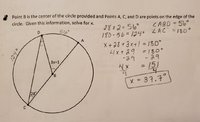Can someone tell me if I did this right? I understand that with inscribed angles, the big/outer angle is twice as big as the inner angle, however, this problem just states to solve for X. It didn't mention finding any angles or degrees ( I just wrote them in anyway because I like to show everything).
Thanks!
Thanks!

